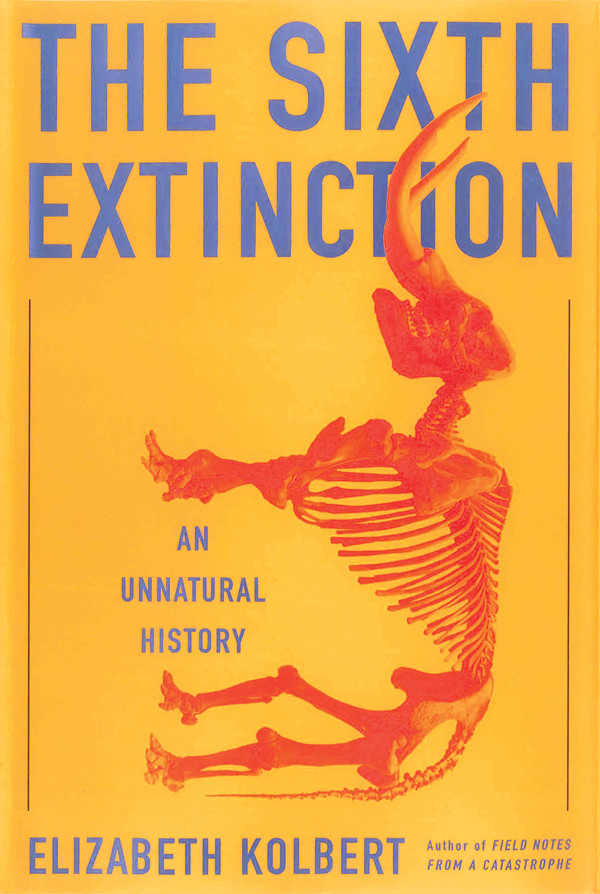
by Callan Bentley Monday, December 8, 2014

"The Sixth Extinction: An Unnatural History," by Elizabeth Kolbert, Henry Holt and Co., 2014, 9780805092998.
Last year, Elizabeth Kolbert released her latest excellent book. Her previous volume, “Field Notes from a Catastrophe,” set a high bar for accessible, accurate science writing about environmental issues, but in my opinion, “The Sixth Extinction” surpasses it in several regards. Readers of this magazine will appreciate its solid geologic grounding and perspective, with entire chapters devoted to the end-Ordovician and end-Cretaceous extinctions, as well as sections on the principles of evolution and Earth history. Climate change, the focus of her earlier book, looms large here too, though it is just one of the many threats to the survival of our biosphere that Kolbert covers.
As a geoscientist, I knew I was going to like this book when I read an advance excerpt in The New Yorker (for which Kolbert is staff writer) a few months before publication. It was all about graptolites, and how they once littered the seas like hairs on a barber’s floor. Now, of course, we have no graptolites. Where did they go? Can a species, a genus, a family, simply cease to exist? We now know they can. Such a concept was once unthinkable on religious grounds, but science led some people to think it anyway. Kolbert recounts the history of thinking about extinction, principally through the work of Georges Cuvier, Charles Lyell and of course Charles Darwin, for whom irreversible death of a species was a foundational precept in his proposal of natural selection.
The discovery of mastodon fossils by French troops along the Ohio River in 1739 is offered as a thought-provoking example. Although known in the Old World, the teeth were so fundamentally different (cusped with “teat”-like points) that they were inferred to be those of a giant. Comte de Buffon was perplexed by these odd bones, and Thomas Jefferson tried to spin them as evidence of America’s machismo. But Cuvier, coming at the remains without agenda or guile, used the mastodon as the centerpiece of a famous talk that showed the world that extinction happens.
Several contemporary case studies are offered: the Panamanian golden frog, the passenger pigeon, and the great auk, all of which end badly. But there is good news when it comes to California condors and pandas and the Sumatran rhinoceros, thanks to the rigorous work of dedicated conservationists. Some tales are left unfinished. Primary among these is the ongoing saga of bats in eastern North America, where the introduction of a European fungus in the last decade has caused 90 percent mortality in some caves. We are creating a veritable “new Pangaea,” Kolbert writes, where humans, rather than tectonics, are bringing disparate populations together, and only the lucky survive.
Habitat fragmentation, invasive species and the desperate acts of conservation biologists all merit attention. For each, Kolbert takes us to exotic corners of the world — the Great Barrier Reef, the Amazonian highlands, Panama, the Mediterranean — to visit the scientists on the front lines, quantifying the scope of these threats in the real, changing world.
The big success of this book over “Field Notes” is its diversity and comprehensiveness. The current ecological crisis is a concatenation of circumstances, all of which require our attention. If we specialize in climate change, we might miss the importance of habitat fragmentation. If we focus only on invasive species, we might miss the bigger story. If we study only ammonites, we might miss the passing of the Panamanian golden frog.
Scientists studying the current episode of earth system change should be grateful to Kolbert for crafting such a vital, sweeping summary of our species’ potentially most lasting legacy: a widespread extinction occurring at a rate comparable to the greatest the planet has ever seen.
© 2008-2021. All rights reserved. Any copying, redistribution or retransmission of any of the contents of this service without the expressed written permission of the American Geosciences Institute is expressly prohibited. Click here for all copyright requests.